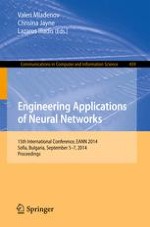This volume constitutes the refereed proceedings of the 15th International Conference on Engineering Applications of Neural Networks, EANN 2014, held in Sofia, Bulgaria, in September 2014. The 18 revised full papers presented together with 5 short papers were carefully reviewed and selected from 37 submissions. The papers demonstrate a variety of applications of neural networks and other computational intelligence approaches to challenging problems relevant to society and the economy. These include areas such as: environmental engineering, facial expression recognition, classification with parallelization algorithms, control of autonomous unmanned aerial vehicles, intelligent transport, flood forecasting, classification of medical images, renewable energy systems, intrusion detection, fault classification and general engineering.
